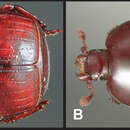Description
provided by Zookeys
This species is extremely similar to Operclipygus dubitabilis, differing as follows: length: 2.18 mm, width: 1.90 mm; frontal stria fragmented at middle; epistoma not at all depressed, lacking fragments of lateral striae; pronotum with lateral submarginal stria shallowly impressed, disk not depressed mediad; pronotal disk with only few small coarse lateral punctures; pygidium lacking marginal stria, with barely visible crease near apex. Male genitalia (Fig. 27): accessory sclerites present; T8 elongate, parallel-sided, basal apodemes only slightly divergent, basal emargination narrow, deep, with basal membrane attachment line distad by about one-fourth basal emargination depth, apical emargination narrow; ventrolateral apodemes narrow, well separated beneath; S8 with apical guides narrow for most of length, abruptly widened at apex, halves approximate in basal fourth, diverging to apex; T9 with apices curving, subacute; T10 with halves separate; S9 narrow at middle, evenly expanded to narrowly rounded base, apex shallowly arcuate, without distinct median emargination, with apical flange narrowed at middle; tegmen slender, with rounded sides slightly narrowing to base, narrowing in apical half to subacute apices, apex moderately curved ventrad; medioventral process small but well sclerotized, ‘U’-shaped, situated about one-fourth tegmen length from base, projecting beneath; basal piece about one-third tegmen length; median lobe about one-third tegmen length, slender.
- license
- cc-by-3.0
- copyright
- Michael S. Caterino, Alexey K. Tishechkin
- bibliographic citation
- Caterino M, Tishechkin A (2013) A systematic revision of Operclipygus Marseul (Coleoptera, Histeridae, Exosternini) ZooKeys 271: 1–401
- author
- Michael S. Caterino
- author
- Alexey K. Tishechkin

